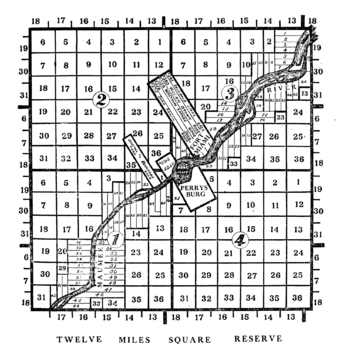Twelve Mile Square Reservation facts for kids
The Twelve Mile Square Reservation, also known as the Twelve Mile Square Reserve, was a special area of land in Ohio. Native American tribes gave this land to the United States in a peace agreement called the Treaty of Greenville in 1795. This specific piece of land, which was right around Fort Miami, was very important to the United States government for military reasons. Because it was so important, it was measured and divided differently from the land around it. Then, parts of it were sold or given to new settlers.
History of the Land
In 1680, Frontenac, who was the French Governor of Canada, built Fort Miami on the west side of the Maumee River. This was the first fort built by non-Native people in Ohio. The fort was used for trading for a short time, then it was left empty.
Later, during the Northwest Indian War, the British rebuilt Fort Miami. They did this to help the Native American tribes who were fighting against the Americans. However, the Americans won an important battle nearby called the Battle of Fallen Timbers in 1794.
After this battle, the Treaty of Greenville was signed. This treaty meant that a large part of southern and eastern Ohio was given to the United States. The treaty also included other specific areas, like the Twelve Mile Square Reservation. It was described as "One piece twelve miles square, at the British fort on the Miami of the Lake, at the foot of the rapids." At that time, the Maumee River was called the "Miami of the Lake." The "foot of the rapids" is now located between the towns of Maumee and Perrysburg. In 1795, another agreement called Jay's Treaty led to the British leaving Fort Miami in 1796.
How the Land Was Divided and Settled
Even before the United States took control, many white settlers had moved near Fort Miami while the French and British were there. The United States wanted to give these people official ownership of their land. They also wanted to sell the rest of the land in the reservation.
To do this, in 1805, the United States Congress decided on a special way to measure the reserve. A surveyor named Elias Glover divided the area into four large sections, each six miles (about 10 km) square. These sections were called townships. The southwest township was number one, the northwest was number two, the northeast was number three, and the southeast was number four. This area was measured in a unique way and was not connected to other land surveys done later in 1821.
In 1807, the U.S. Congress decided that anyone who had been living on and improving a piece of land in the reserve before July 1, 1796, could officially own that land. They would receive a special document called a land patent to prove their ownership.
Each of the four townships was further divided into 36 smaller sections, each about one square mile (2.6 square kilometers). These sections were numbered in a special zig-zag pattern. In 1816, another surveyor named Joseph Wampler measured the land along the river. He created long, narrow plots of land, each about 160 acres (0.65 square kilometers), which were called "River Tracts." There were 93 of these.
The land claims of the British and French settlers were measured in 1817. Any parts of the sections left over after the River Tracts were created were called "Fractional Sections." The law of 1816 also set aside section 16 in each township as School Lands. These lands were meant to help fund schools in each township and were eventually sold. Town lots in Perrysburg were also planned in 1816. Land in the reservation was sold through the Wooster Land Office.
The Reservation Today
The Twelve Mile Square Reservation today covers parts of Wood and Lucas counties in Ohio. It includes the towns of Perrysburg, Maumee, and the southern suburbs of Toledo, Ohio.
You can find the corners of the original reservation at these locations:
- The northwest corner is just northwest of the intersection of Dorr and Crissey roads.
- The northeast corner is northeast of the MLK Bridge within the Maumee River.
- The southeast corner is at the intersection of Tracy and Dowling roads.
- The southwest corner is northeast of the intersection of Neowash and Noward roads.



